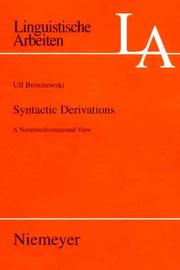| Listing 1 - 2 of 2 |
Sort by
|
Book
ISBN: 9781441126054 1441126058 1441195505 9781441195500 9781441172501 1441172505 9781441195043 1441195041 1282576852 9786612576850 9781282576858 6612576855 Year: 2010 Publisher: London : Continuum International Pub. Group,
Abstract | Keywords | Export | Availability | Bookmark
 Loading...
Loading...Choose an application
- Reference Manager
- EndNote
- RefWorks (Direct export to RefWorks)
In this book, Miriam Urgelles-Col examines the syntax and semantics of discourse markers. A discourse marker can loosely be defined as an item such as well or now , coming at the beginning of an utterance and marking a boundary between one part of spoken discourse and the next, signalling the start of a new section of the discourse. They perform important functions in conversation -- but defining discourse markers is problematic in itself. The syntactic approach employed in this book to describe discourse markers is Head-Driven Phrase Structure Grammar (HPSG) which is relevant in a theory of
Discourse markers. --- Head-driven phrase structure grammar. --- REFERENCE. --- LANGUAGE ARTS & DISCIPLINES --- Discoursanalyse. --- Sociolinguïstiek. --- Vocabulary. --- Discourse markers --- Grammar, Comparative and general --- Semantics --- Head-driven phrase structure grammar --- Languages & Literatures --- Philology & Linguistics --- Syntax --- Reference. --- Language arts & disciplines --- Discourse analysis. --- Sociolinguistics. --- Language and languages --- Language and society --- Society and language --- Sociology of language --- Discourse grammar --- Text grammar --- Discourse connectives --- Discourse particles --- Pragmatic markers --- Pragmatic particles --- Social aspects --- Sociological aspects --- Marqueurs discursifs --- Grammaire de constituants --- Language and culture --- Linguistics --- Sociology --- Integrational linguistics (Oxford school) --- Semiotics --- Discourse analysis --- Pragmatics --- Lexicology. Semantics --- Grammar --- Semantics. --- Syntaxe --- Sémantique --- Analyse du discours --- Syntax. --- Sémantique. --- Marqueurs discursifs. --- Syntaxe. --- Grammaire de constituants. --- Analyse du discours. --- Sémantique.

ISBN: 3484304707 3110953560 9783110953565 9783484304703 Year: 2003 Publisher: Tübingen : M. Niemeyer,
Abstract | Keywords | Export | Availability | Bookmark
 Loading...
Loading...Choose an application
- Reference Manager
- EndNote
- RefWorks (Direct export to RefWorks)
This study investigates a model of syntactic derivations that is based on a new concept of dislocation, i.e., of 'movement' phenomena. Derivations are conceived of as a compositional process that constructs larger syntactic units out of smaller ones without any phrase-structure representations, as in categorial grammars. It is demonstrated that a simple extension of this view can account for dislocation without gap features, chains, or structural transformations. Basically, it is assumed that movement 'splits' a syntactic expression into two parts, which form a derivational unit but enter separately into the formation of larger constituents. The study shows that in this approach, if common assumptions about selection and licensing are added, a small and coherent set of axioms suffices to deduce fundamental syntactic generalizations that transformational theories express in terms of X-bar-Theory and various constraints on movement. These generalizations include, for example, equivalents to the C-Command Condition and the Head Movement Constraint, the 'structure-preserving' nature of dislocation, its 'economical' character, and elementary bounding principles.
Constituent structure grammar --- Grammaire structurale des constituants de la phrase --- Grammaire à structure de phrase --- Structuurgrammatica van de woordgroepen --- Woordgroepstructuur-grammatica --- Phrase structure grammar. --- Grammar, Comparative and general --- Phrase structure grammar --- Grammar, Phrase structure --- Generative grammar --- Language and languages --- Syntax --- Syntax. --- Grammar [Comparative and general ] --- Linguistics --- Philology --- Grammar, Comparative and general Syntax --- Grammaire comparée et générale --- Syntaxe
| Listing 1 - 2 of 2 |
Sort by
|

 Search
Search Feedback
Feedback About UniCat
About UniCat  Help
Help News
News